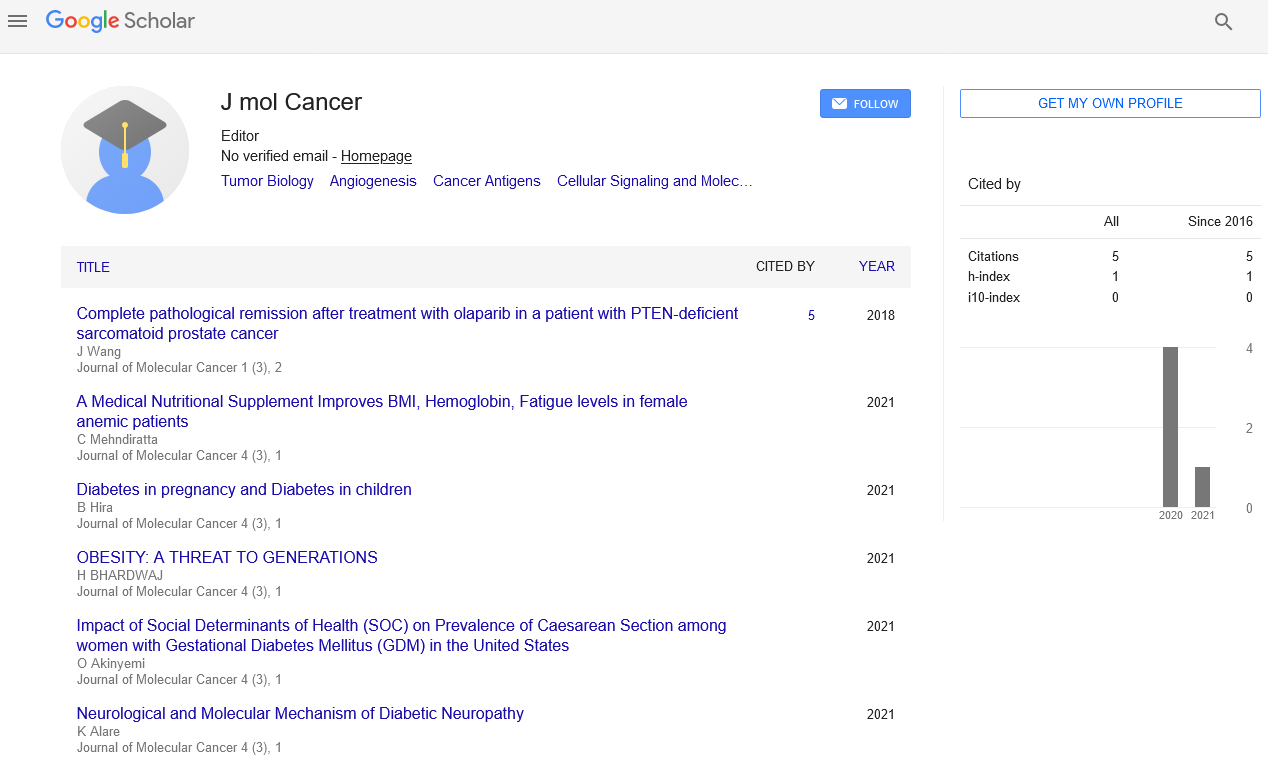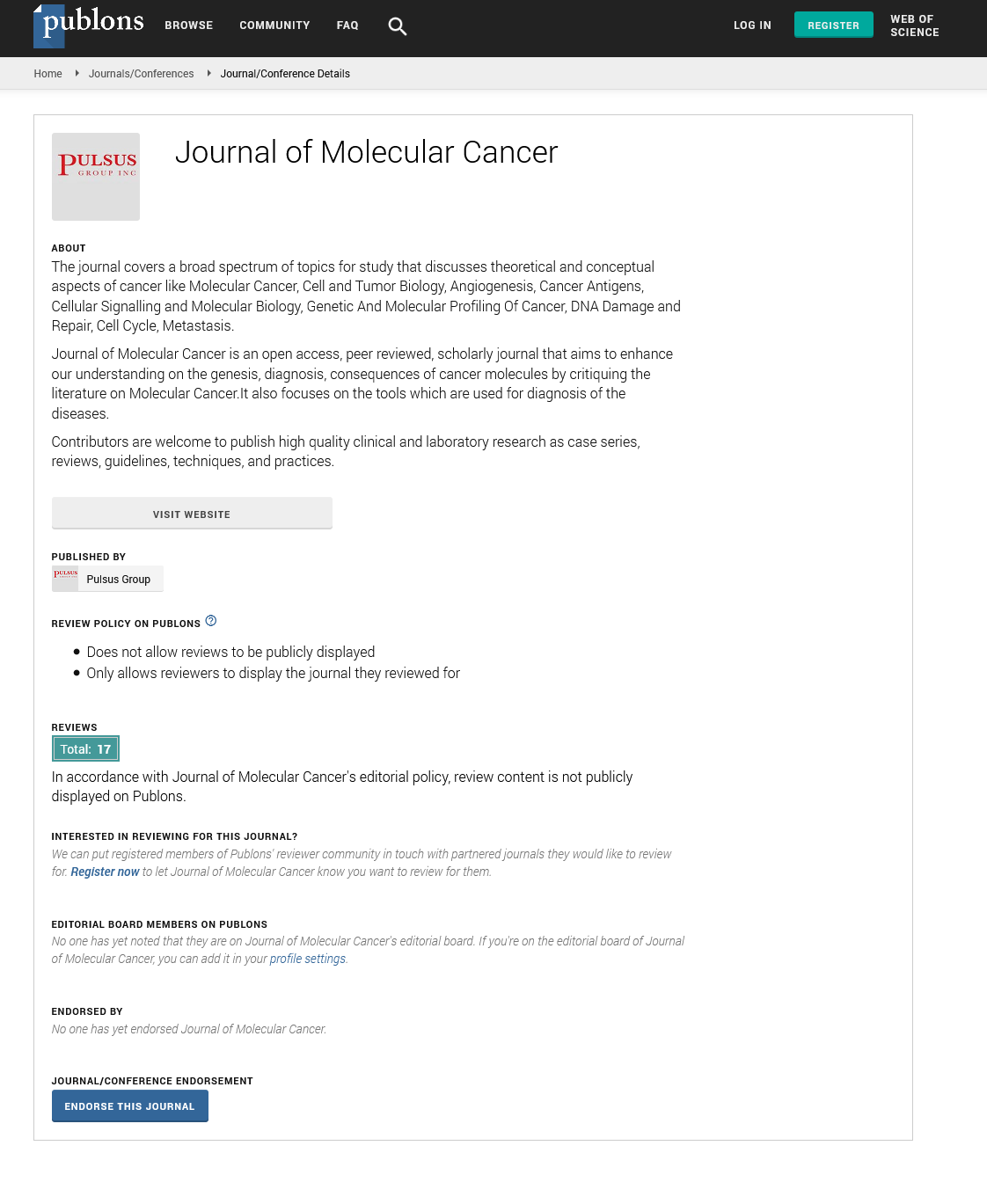Perseveration: Repetition of a particular response
Received: 14-Mar-2022, Manuscript No. puljmc-22-4482; Editor assigned: 16-Mar-2022, Pre QC No. puljmc-22-4482(PQ); Accepted Date: Mar 14, 2022; Reviewed: 21-Mar-2022 QC No. puljmc-22-4482(Q); Revised: 25-Mar-2022, Manuscript No. puljmc-22-4482(R); Published: 28-Mar-2022, DOI: DOI:10.37532/puljmc.22.5(2).8-9
Citation: Grey C. Perseveration: repetition of a particular response. J Mol Cancer. 2022; 5(2):8-9.
This open-access article is distributed under the terms of the Creative Commons Attribution Non-Commercial License (CC BY-NC) (http://creativecommons.org/licenses/by-nc/4.0/), which permits reuse, distribution and reproduction of the article, provided that the original work is properly cited and the reuse is restricted to noncommercial purposes. For commercial reuse, contact reprints@pulsus.com
Abstract
Persevering disease cells are the discrete and normally undetected cells that endure malignant growth drug treatment and comprise a significant reason for treatment disappointment. These cells are portrayed by their sluggish multiplication, profoundly adaptable energy utilization, variation to their microenvironment, and phenotypic versatility. Systems that underlie their tirelessness offer profoundly pined for and sought-after helpful targets, and incorporate assorted epigenetic, transcriptional, and translational administrative cycles, as well as intricate cell-cell collaborations. Albeit the effective clinical focusing of persevering malignant growth cells still needs to be understood, huge headway has been made in getting their ingenuity, yielding promising preclinical outcomes.
Key Words
Positron discharge tomography; CTLA4; Histocompatibility
Abstract
Persevering disease cells are the discrete and normally undetected cells that endure malignant growth drug treatment and comprise a significant reason for treatment disappointment. These cells are portrayed by their sluggish multiplication, profoundly adaptable energy utilization, variation to their microenvironment, and phenotypic versatility. Systems that underlie their tirelessness offer profoundly pined for and sought-after helpful targets, and incorporate assorted epigenetic, transcriptional, and translational administrative cycles, as well as intricate cell-cell collaborations. Albeit the effective clinical focusing of persevering malignant growth cells still needs to be understood, huge headway has been made in getting their ingenuity, yielding promising preclinical outcomes.
Introduction
This is on the grounds that imperceptible lingering disease cells continue in the body after treatment and can ultimately and eccentrically lead to metastatic backslides. Most patients with metastatic malignant growths, who have what is portrayed by oncologists as an incomplete or complete reaction to therapy with disease drugs, at last backslide. These backslides can happen after months or even years even without any perceptible growths following treatment, as evaluated by utilizing the most refined picture strategies, for example, automated tomography examine, Positron Discharge Tomography (PET) filter, and attractive reverberation imaging. This is a result of the presence of lingering illness, which makes a repository that brings about drug-safe cells. Disease patients answer treatment in an assortment of ways. One as often as possible noted reaction in patients being treated for metastatic diseases is that of separated or blended reactions, where a few metastases answer treatment though others don't. These supposed separated reactions make the administration of patients more mind boggling on the grounds that treatment interference can bring about the development of nonanswering, as well as of answering, metastases, regularly driving doctors to proceed with treatment past illness movement. Stable sickness is another reaction type. It is seen, for instasnce, when cytostatic drugs, like hormonal receptor blockers, are utilized to treat chemical delicate malignant growths. Stable infection could be connected with growths in which disease cell multiplication is exceptionally sluggish or is adjusted by disease cell demise. Subsequently, almost certainly, disease cells continue and are ubiquitous in a wide range of clinical reaction. Doctors know about the presence and ingenuity of these equivocal cells, as are frequently hesitant to let their patients know that they are restored; all things being equal, they allude to growth free periods as lengthy abatements. This clinical reality features the pressing need to all the more likely comprehend the science of this undetectable foe determined to obliterate or killing it.
Conclusion
As talked about above, industriousness has been widely contemplated with regards to chemotherapy or designated treatment. These examinations frequently ignored the way that constant disease cells should likewise sidestep from or be endured by invulnerable observation, to get by in the immunocompetent living beings. For sure, very little data is accessible concerning the instruments of safe obliviousness or insusceptible avoidance created by tenacious malignant growth cells. Along a similar line, it isn't certain if comparative steady cell state can likewise exist following immunotherapy, for instance as a resistant designated spot bar or Receptive Exchange T Cells (ACT). It is realized that cancer cells could take advantage of various components to get away from safe reconnaissance, like diminished articulation of Significant Histocompatibility Complex (MHC) or expanded articulation of negative safe designated spot factors, like TIM3 or LAG3. Undifferentiated organism like mouse squamous cell carcinoma cells that experience ACT immunotherapy specifically express CD80, which empowers them to upregulate Cytotoxic T Lymphocyte Antigen-4 (CTLA4) to straightforwardly hose cytotoxic T cell movement. Cancer determined CCL21 makes an invulnerable lenient microenvironment by instigating lymphoid-like reticular stromal networks that rely upon have CCR7-communicating cells in human melanoma. Without a doubt, upon feeling by CCL21, as well as by IL-7, the host CCR7-communicating cells, specifically fibroblastic reticular cells, change the cancer depleting lymph hub into an immunosuppressive advantaged site and advance growth safe avoidance. Disease perseverance permits a populace of malignant growth cells to endure chemotherapeutic attack and to stay concealed in the patient's body until they in the end bring about clinical movement. All things considered, malignant growth cell perseverance gives off an impression of being the most provoking impediment to compelling and solid anticancer therapy. Various systems have been accounted for to clarify this constancy peculiarity. Albeit a huge number of likely remedial ways to deal with target disease industriousness have been proposed, at this point none has been effectively converted into clinical use. This may be because of the way that current helpful strategies have not incorporated the numerous systems of industriousness to all the while battle their metabolic and multiplication attributes, their dynamic versatility, and their intricate associations with the cancer microenvironment. New remedial methodologies focusing on tenacious malignant growth cells are hence critically expected to break the roof glass of medication opposition.






